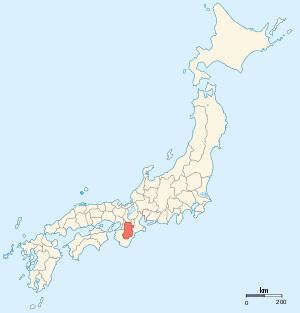 | ||
Yamato Province (大和国, Yamato no Kuni) was a province of Japan, located in Kinai, corresponding to present-day Nara Prefecture in Honshū. It was also called Washū (和州). At first, the name was written with one different character (大倭; cf. Names of Japan), and for about ten years after 737, this was revised to use more desirable characters (大養徳). The final revision was made in the second year of the Tenpyō-hōji era (c. 758). It is classified as a great province in the Engishiki.
Contents
The Yamato Period in the history of Japan refers to the late Kofun Period (c. 250–538) and Asuka Period (538–710). Japanese archaeologists and historians emphasize the fact that during the early Kofun Period the Yamato chieftainship was in close contention with other regional powers, such as Kibi Province near present-day Okayama Prefecture. Around the 6th century, the local chieftainship gained national control and established the Imperial court in Yamato Province.
The battleship Yamato, the flagship of the Japanese Combined Fleet during World War II, was named after this ancient province.
Capital
The provincial capital was Wakigami in Katsujō District (modern northeastern Gose), but accompanying the Heijō-kyō capital transfer, it was moved to Takaichi District (Jōroku in modern Kashihara, where the Ōgaru and Ishikawa towns meet, called Karu no Chimata). The exact location of the capital is guessed at by various sources, but not known for sure. There was no shugo's mansion; the Kōfuku-ji played that role.
In the Setsuyōshū, Toichi District is listed as the seat.
Temples
The provincial temple for monks is popularly thought to have been Tōdai-ji, but it may have in fact been a different one in Kashihara. The one for nuns was Hokke-ji.
The primary shrine was Sakurai's Ōmiwa Shrine, but there have been no records stating as such found at the shrine itself. There were no secondary shrines. The sōja (or principal Shinto shrine in the province) was Kokufu Shrine (Takatori, Takaichi, Nara).
